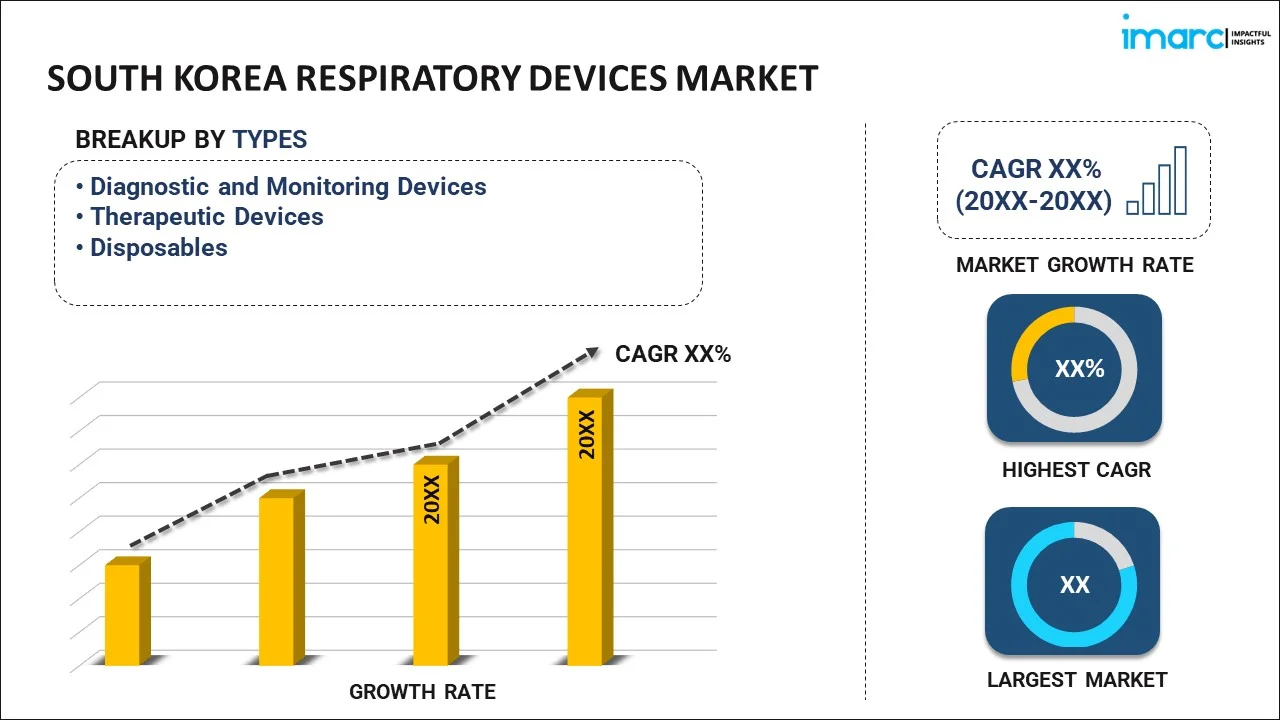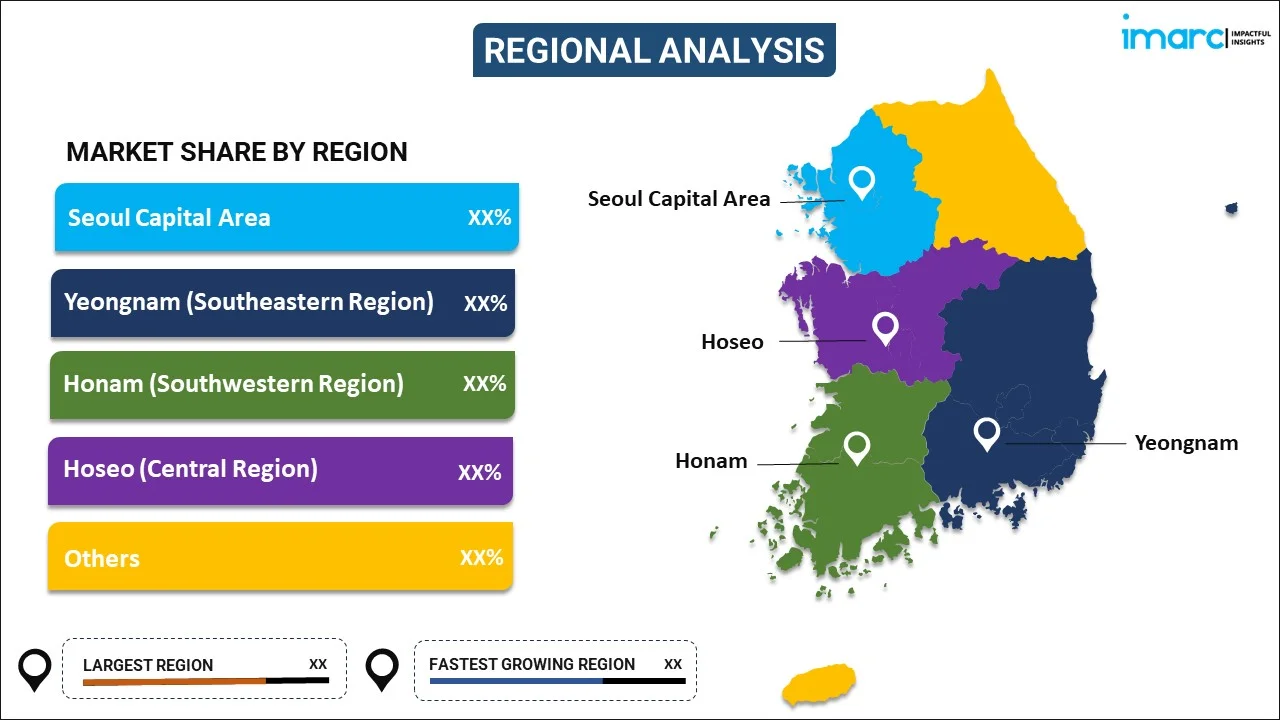
South Korea Respiratory Devices Market Report by Type (Diagnostic and Monitoring Devices, Therapeutic Devices, Disposables), and Region 2026-2034
Market Overview:
South Korea respiratory devices market size reached USD 505.0 Million in 2025. Looking forward, IMARC Group expects the market to reach USD 805.1 Million by 2034, exhibiting a growth rate (CAGR) of 5.32% during 2026-2034. The rising prevalence of respiratory diseases, an aging population across the country, heightened public awareness about respiratory health, and the presence of an advanced healthcare infrastructure represent some of the key factors driving the market.
|
Report Attribute
|
Key Statistics
|
|---|---|
|
Base Year
|
2025
|
|
Forecast Years
|
2026-2034
|
|
Historical Years
|
2020-2025
|
| Market Size in 2025 | USD 505.0 Million |
| Market Forecast in 2034 | USD 805.1 Million |
| Market Growth Rate 2026-2034 | 5.32% |
Access the full market insights report Request Sample
Respiratory devices are critical medical equipment designed to assist or replace the natural function of the respiratory system. These devices range from simple oxygen masks to complex mechanical ventilators. They are particularly useful in treating conditions that impair breathing, such as asthma, chronic obstructive pulmonary disease (COPD), and pneumonia. Mechanical ventilators, for instance, are taking over the role of breathing for patients who are unable to do so themselves, often in intensive care settings. On the other hand, simpler devices like inhalers are aiding individuals in managing respiratory conditions on a day-to-day basis. Continuous Positive Airway Pressure (CPAP) machines provide relief to people suffering from sleep apnea by ensuring a constant flow of air to keep airways open during sleep. Nebulizers convert liquid medication into mist form for easy inhalation directly into the lungs. These devices undergo rigorous testing and approvals to ensure safety and efficacy, often by organizations such as the U.S. Food and Drug Administration (FDA) or the European Medicines Agency (EMA). They are essential in medical facilities as well as for home care, especially for older adults and those requiring long-term therapy. As a result, respiratory devices play an invaluable role in healthcare by improving the quality of life for patients worldwide.
South Korea Respiratory Devices Market Trends:
The South Korea respiratory devices market is currently experiencing significant growth, driven by a number of key factors. Foremost among them is the rising prevalence of respiratory diseases, such as asthma, chronic obstructive pulmonary disease (COPD), and pneumonia. Moreover, the aging population that is more susceptible to respiratory conditions is further contributing to the market growth. In addition, South Korea's advanced healthcare infrastructure and medical research capabilities are playing a critical role in fueling the demand for high-quality respiratory devices. The government's focus on healthcare expenditure and the increasing adoption of sophisticated medical technologies are also supporting market growth. For instance, there is an ongoing commitment to R&D in medical sciences, as evidenced by state-sponsored programs and initiatives that foster innovation. Furthermore, South Korea's well-established network of hospitals and clinics is another major factor catalyzing the demand for respiratory devices. In line with this, the widespread availability of health insurance in the country ensures that a broad segment of the population can access these life-saving devices, thereby propelling market growth. Besides this, there is a rising trend toward home healthcare solutions, especially in the wake of the coronavirus (COVID-19) pandemic, which has highlighted the importance of having quality respiratory devices available for home use. This, coupled with the heightened public awareness about respiratory health, has fueled the need for such devices. Apart from this, significant expansion in international trade, with South Korea both importing advanced devices and exporting domestically manufactured products, is expected to stimulate market growth in the coming years.
South Korea Respiratory Devices Market Segmentation:
IMARC Group provides an analysis of the key trends in each segment of the market, along with forecasts at the country level for 2026-2034. Our report has categorized the market based on type.
Type Insights:

To get detailed segment analysis of this market Request Sample
- Diagnostic and Monitoring Devices
- Spirometers
- Sleep Test Devices
- Others
- Therapeutic Devices
- Positive Airway Pressure (PAP) Devices
- Humidifiers
- Nebulizers
- Ventilators
- Inhalers
- Others
- Disposables
The report has provided a detailed breakup and analysis of the market based on the type. This includes diagnostic and monitoring devices (spirometers, sleep test devices, and others), therapeutic devices (positive airway pressure (PAP) devices, humidifiers, nebulizers, ventilators, inhalers, and others), and disposables.
Regional Insights:

To get detailed regional analysis of this market Request Sample
- Seoul Capital Area
- Yeongnam (Southeastern Region)
- Honam (Southwestern Region)
- Hoseo (Central Region)
- Others
The report has also provided a comprehensive analysis of all the major regional markets, which include Seoul Capital Area, Yeongnam (Southeastern Region), Honam (Southwestern Region), Hoseo (Central Region), and others.
Competitive Landscape:
The market research report has also provided a comprehensive analysis of the competitive landscape in the market. Competitive analysis such as market structure, key player positioning, top winning strategies, competitive dashboard, and company evaluation quadrant has been covered in the report. Also, detailed profiles of all major companies have been provided.
South Korea Respiratory Devices Market Report Coverage:
| Report Features | Details |
|---|---|
| Base Year of the Analysis | 2025 |
| Historical Period | 2020-2025 |
| Forecast Period | 2026-2034 |
| Units | Million USD |
| Scope of the Report | Exploration of Historical and Forecast Trends, Industry Catalysts and Challenges, Segment-Wise Historical and Predictive Market Assessment:
|
| Types Covered |
|
| Regions Covered | Seoul Capital Area, Yeongnam (Southeastern Region), Honam (Southwestern Region), Hoseo (Central Region), Others |
| Customization Scope | 10% Free Customization |
| Post-Sale Analyst Support | 10-12 Weeks |
| Delivery Format | PDF and Excel through Email (We can also provide the editable version of the report in PPT/Word format on special request) |
Key Questions Answered in This Report:
- How has the South Korea respiratory devices market performed so far and how will it perform in the coming years?
- What has been the impact of COVID-19 on the South Korea respiratory devices market?
- What is the breakup of the South Korea respiratory devices market on the basis of type?
- What are the various stages in the value chain of the South Korea respiratory devices market?
- What are the key driving factors and challenges in the South Korea respiratory devices?
- What is the structure of the South Korea respiratory devices market and who are the key players?
- What is the degree of competition in the South Korea respiratory devices market?
Key Benefits for Stakeholders:
- IMARC’s industry report offers a comprehensive quantitative analysis of various market segments, historical and current market trends, market forecasts, and dynamics of the South Korea respiratory devices market from 2020-2034.
- The research report provides the latest information on the market drivers, challenges, and opportunities in the South Korea respiratory devices market.
- Porter's five forces analysis assist stakeholders in assessing the impact of new entrants, competitive rivalry, supplier power, buyer power, and the threat of substitution. It helps stakeholders to analyze the level of competition within the South Korea respiratory devices industry and its attractiveness.
- Competitive landscape allows stakeholders to understand their competitive environment and provides an insight into the current positions of key players in the market.
Need more help?
- Speak to our experienced analysts for insights on the current market scenarios.
- Include additional segments and countries to customize the report as per your requirement.
- Gain an unparalleled competitive advantage in your domain by understanding how to utilize the report and positively impacting your operations and revenue.
- For further assistance, please connect with our analysts.
 Request Customization
Request Customization
 Speak to an Analyst
Speak to an Analyst
 Request Brochure
Request Brochure
 Inquire Before Buying
Inquire Before Buying




.webp)




.webp)












